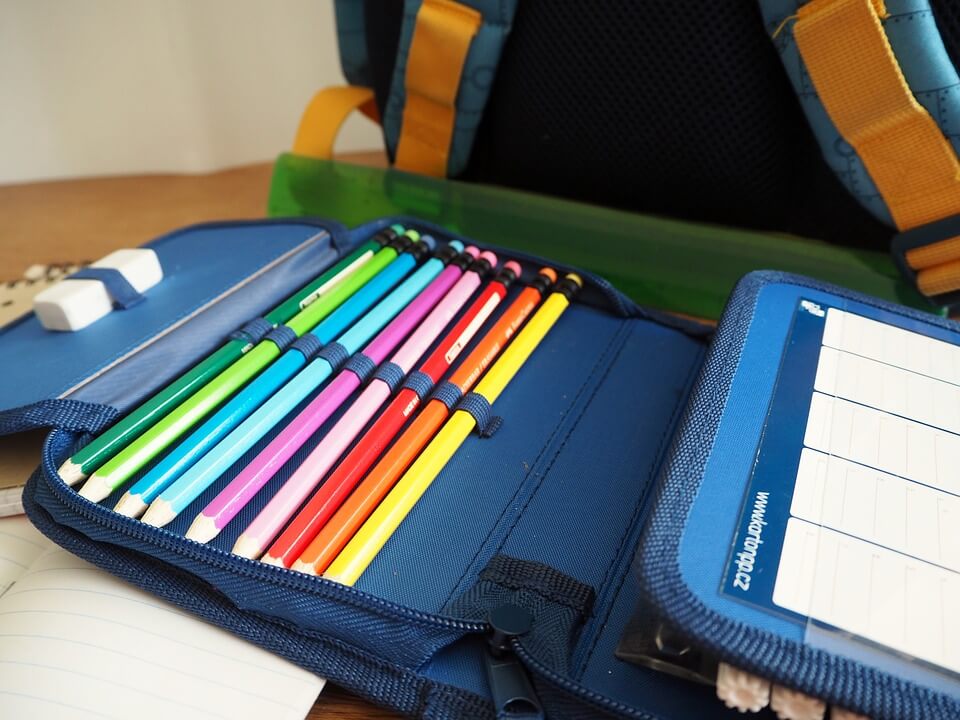Tips for Packing Your Child's Backpack for School


Reviewed and approved by the psychopedagogue María José Roldán
How do you pack a child’s backpack for school? This is a common question among parents preparing to send their kids off to class.
Despite the fact that most schools provide a list of supplies the child will need, it’s up to us as parents to choose the right backpack and make sure that our kids can carry everything comfortably.
To this end, we’ll take a look at some ideas regarding how to best pack for school. We’ll also consider the best type of backpack to choose. This is something that often gets ignored, but has a real impact on the child’s well-being.
Choosing the right backpack
Let’s start by considering the best type of backpack for our kids to carry their school supplies. Pediatricians say that most children who experience back pain carry too much weight in their backpacks, or aren’t using the right model.
The types of backpacks available on the market come with two straps, one strap, or suitcase-style wheels. Of these three options, orthopedists recommend the two-strap version.
This model is considered to have the best weight distribution for avoiding back ailments. If you choose this model, make sure the straps are wide and padded to allow for greater comfort on your child’s shoulders.
While it may seem like the suitcase-style version is ideal, dragging it with one arm can cause a curvature in the spine, as the effort makes the child lean forward. In addition, it will also make it more difficult for the child to climb stairs and go over gratings.
Packing school supplies
When packing your child’s backpack, keep in mind that you should never include more than is necessary. To achieve this goal, you need to have a copy of your child’s class schedule so that you can know what needs to be packed for each day.

Once you know which notebooks, books and supplies he or she needs the following day, you should pack them in the following order:
- Books and notebooks should go in the part of the backpack closest to the back. In other words, they should go in first.
- Heavy objects like pencil cases and tablets (if used) should go in next. Remember that the best bases are made with resistant fabrics, versatile enough to carry the largest number of pencils and colored pencils in a single space. The case should include: pencils, erasers, colored pencils, safety scissors, markers, a ruler, and a glue stick.
- If you put the child’s snack in the backpack, it should come next. Ideally, your child’s backpack will have side pockets, inner pockets, and front pockets so you can add a spill-proof water bottle and a sandwich container.
- Finally, add light items like baby wipes, antibacterial gel, tissues, and a change of clothes if your child plays a sport. This is very important if your child is in preschool because children of that age get dirty easily.

Final considerations for your child’s backpack
If possible, weigh your child’s backpack. Pediatricians and orthopedists recommend that its weight should never exceed 15% of the child’s body weight. Therefore, a backpack shouldn’t weigh more than two to five kilograms (about 5-10 pounds) for kids aged five to 11.
Let your child choose the colors and patterns of the backpack, but decide on its shape and weight yourself. This will ensure that he or she doesn’t come home with back pain from using the wrong model.
With all this in mind, you know how to take care of your child’s backpack. We’ve given you all the tools your need, so get started! And make sure to wish your little one plenty of success at school.
How do you pack a child’s backpack for school? This is a common question among parents preparing to send their kids off to class.
Despite the fact that most schools provide a list of supplies the child will need, it’s up to us as parents to choose the right backpack and make sure that our kids can carry everything comfortably.
To this end, we’ll take a look at some ideas regarding how to best pack for school. We’ll also consider the best type of backpack to choose. This is something that often gets ignored, but has a real impact on the child’s well-being.
Choosing the right backpack
Let’s start by considering the best type of backpack for our kids to carry their school supplies. Pediatricians say that most children who experience back pain carry too much weight in their backpacks, or aren’t using the right model.
The types of backpacks available on the market come with two straps, one strap, or suitcase-style wheels. Of these three options, orthopedists recommend the two-strap version.
This model is considered to have the best weight distribution for avoiding back ailments. If you choose this model, make sure the straps are wide and padded to allow for greater comfort on your child’s shoulders.
While it may seem like the suitcase-style version is ideal, dragging it with one arm can cause a curvature in the spine, as the effort makes the child lean forward. In addition, it will also make it more difficult for the child to climb stairs and go over gratings.
Packing school supplies
When packing your child’s backpack, keep in mind that you should never include more than is necessary. To achieve this goal, you need to have a copy of your child’s class schedule so that you can know what needs to be packed for each day.

Once you know which notebooks, books and supplies he or she needs the following day, you should pack them in the following order:
- Books and notebooks should go in the part of the backpack closest to the back. In other words, they should go in first.
- Heavy objects like pencil cases and tablets (if used) should go in next. Remember that the best bases are made with resistant fabrics, versatile enough to carry the largest number of pencils and colored pencils in a single space. The case should include: pencils, erasers, colored pencils, safety scissors, markers, a ruler, and a glue stick.
- If you put the child’s snack in the backpack, it should come next. Ideally, your child’s backpack will have side pockets, inner pockets, and front pockets so you can add a spill-proof water bottle and a sandwich container.
- Finally, add light items like baby wipes, antibacterial gel, tissues, and a change of clothes if your child plays a sport. This is very important if your child is in preschool because children of that age get dirty easily.

Final considerations for your child’s backpack
If possible, weigh your child’s backpack. Pediatricians and orthopedists recommend that its weight should never exceed 15% of the child’s body weight. Therefore, a backpack shouldn’t weigh more than two to five kilograms (about 5-10 pounds) for kids aged five to 11.
Let your child choose the colors and patterns of the backpack, but decide on its shape and weight yourself. This will ensure that he or she doesn’t come home with back pain from using the wrong model.
With all this in mind, you know how to take care of your child’s backpack. We’ve given you all the tools your need, so get started! And make sure to wish your little one plenty of success at school.
This text is provided for informational purposes only and does not replace consultation with a professional. If in doubt, consult your specialist.








